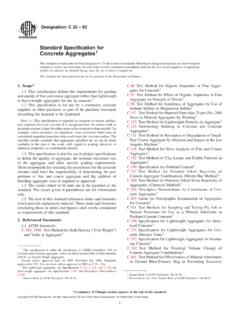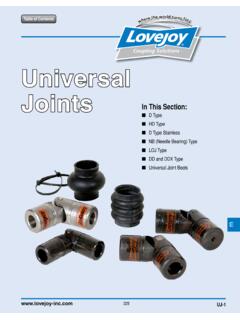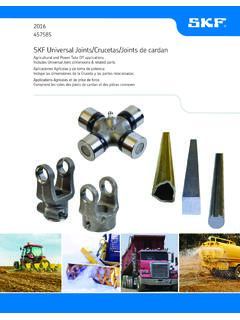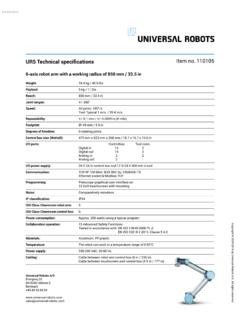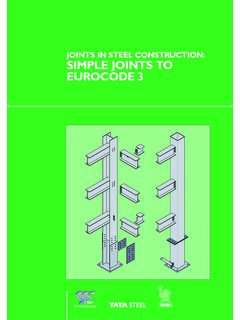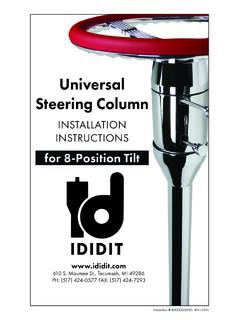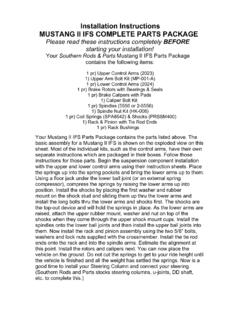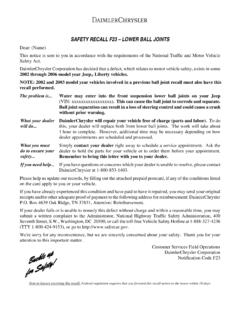Transcription of ACI 224.3R-95 Joints in Concrete Construction
1 Report reviews the state of the art in design, Construction , and mainte-nance of Joints in Concrete structures subjected to a wide variety of use andenvironmental conditions. In some cases, the option of eliminating Joints isconsidered. Aspects of various joint sealant materials and jointing tech-niques are discussed. The reader is referred to ACI 504R for a more com-prehensive treatment of sealant materials, and to ACI 224R for a broaddiscussion of the causes and control of cracking in Concrete in the report focus on various types of structures and structuralelements with unique characteristics: buildings, bridges, slabs-on-grade,tunnel linings, canal linings, precast Concrete pipe, liquid-retaining struc-tures, walls, and mass.
2 Bridges, buildings, canals, canal linings, Concrete construc-tion, Construction Joints , contraction Joints , design, environmental engi-neering Concrete structures, isolation Joints , Joints , parking lots,pavements, runways, slabs-on-grade, tunnels, tunnel linings, 1 Introduction, p. Joints in Concrete joint Movement in Concrete Objectives and scopeChapter 2 Sealant materials and jointing techniques,p. Required properties of joint Commercially available Field-molded Accessory Preformed Compression Jointing practiceChapter 3 Buildings, p.
3 Construction Contraction Isolation or expansion jointsChapter 4 Bridges, p. Construction Bridges with expansion Bridges without expansion jointsChapter 5 Slabs-on-grade, p. Contraction jointsACI in Concrete ConstructionReported by ACI Committee 224 Grant T. Halvorsen* ChairmanRandall W. Poston* SecretaryPeter BarlowDavid W. FowlerHarry M. PalmbaumFlorian G. BarthPeter GergelyKeith A. Pashina*Alfred G. Bishara*Will HansenAndrew ScanlonHoward L. BoggsM. Nadim HassounErnest K. Schrader*Merle E. Brander William LeeWimal SuarisDavid Darwin* To ny C.
4 L i u*Lewis H. Tuthill*Fouad H. Fouad*Edward G. Nawy Zenon A. Zielinski* Principal author. Editorial addition to the above, committee associate member Michael J. Pfeiffer, consulting member LeRoy A. Lutz, past member Arnfinn Rusten, and nonmember Guy S. Puccio (Chairman, Committee 504) were princi-pal authors; Committee 325 member Michael I. Darter was a contributing Committee Reports, Guides, Standard Practices, and Commentariesare intended for guidance in planning, designing, executing, and inspectingconstruction. This document is intended for the use of individuals whoare competent to evaluate the significance and limitations of its con-tent and recommendations and who will accept responsibility for theapplication of the material it contains.
5 The American Concrete Institutedisclaims any and all responsibility for the stated principles. The Instituteshall not be liable for any loss or damage arising to this document shall not be made in contract documents. Ifitems found in this document are desired by the Architect/Engineer to bea part of the contract documents, they shall be restated in mandatory lan-guage for incorporation by the became effective August 1, 1995, American Concrete rights reserved including rights of reproduction and use in any form or by anymeans, including the making of copies by any photo process, or by electronic ormechanical device, printed, written, or oral.
6 Or recording for sound or visual reproduc-tion or for use in any knowledge or retrieval system or device, unless permission inwriting is obtained from the copyright COMMITTEE Isolation or expansion Construction Special considerationsChapter 6 Pavements, p. Contraction Isolation or expansion Construction Hinge or warping Parking lotsChapter 7 Tunnels, canal linings, and pipes, p. Concrete tunnel Concrete canal Concrete pipeChapter 8 Walls, p. Types of Joints in Concrete Contraction Isolation or expansion Construction jointsChapter 9 Liquid-retaining structures, p.
7 Contraction Isolation or expansion Construction jointsChapter 10 Mass Concrete , p. Contraction Construction jointsChapter 11 References, p. Recommended Cited referencesAppendix A Temperatures used for calculation of T,p. 1 Joints in Concrete structuresJoints are necessary in Concrete structures for a variety ofreasons. Not all Concrete in a given structure can be placedcontinuously, so there are Construction Joints that allow forwork to be resumed after a period of time. Since Concrete un-dergoes volume changes, principally related to shrinkageand temperature changes, it can be desirable to provide jointsand thus relieve tensile or compressive stresses that would beinduced in the structure.
8 Alternately, the effect of volumechanges can be considered just as other load effects are con-sidered in building design. Various Concrete structural ele-ments are supported differently and independently, yet meetand match for functional and architectural reasons. In thiscase, compatibility of deformation is important, and jointsmay be required to isolate various engineers view Joints as artificial cracks, or asmeans to either avoid or control cracking in Concrete struc-tures. It is possible to create weakened planes in a structure,so cracking occurs in a location where it may be of little im-portance, or have little visual impact.
9 For these reasons, ACIC ommittee 224 Cracking, has developed this report as anoverview of the design, Construction , and maintenance ofjoints in various types of Concrete structures, expanding onthe currently limited treatment in ACI 224R. While otherACI Committees deal with specific types of structures, andjoints in those structures, this is the first ACI report to syn-thesize information on joint practices into a single 224 hopes that this synthesis will promote con-tinued re-evaluation of recommendations for location andspacing of Joints , and the development of further rational and sometimes conflicting guidelines are foundfor joint spacing.
10 Table reports various recommendationsfor contraction Joints , and Table provides a sampling ofrequirements for expansion Joints . It is hoped that, by bring-ing the information together in this Committee Report, rec-ommendations for joint spacing may become more rational,and possibly more of Construction and structural behavior are impor-tant when comparing the recommendations of Tables andTable Contraction joint spacingsAuthorSpacingMerrill (1943)20 ft (6 m) for walls with frequent openings, 25 ft ( ) in solid (1974)15 to 20 ft ( to 6 m)

